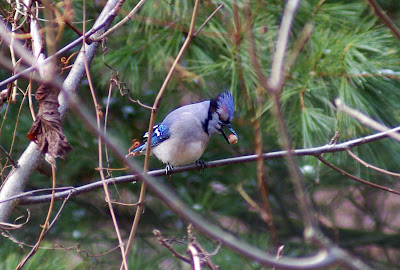 Photo by John Howard
Photo by John HowardThief! Thief! Thief!" the Blue Jay(Cyanocitta cristata) would call from the wild cherry tree in our backyard, complaining of other birds snacking on what he thought was his personal stash. The Blue Jay was one of my favorite birds when I was a kid. It was blue, my favorite color, and it had personality. It would show up at the feeder and challenge other birds to just try and take some of its food. It was top dog and would let all the other birds know it.
It's scientific name of Cyanocitta cristata means "crested blue chattering bird". This description is very appropriate since the Blue Jay is a very noisy bird and can imitate almost anything. I have heard them imitate car alarms, hawks, bells, cats, squeaky gates and growls. Being a member of the crow family, they are also very smart birds. There is one account in an article by R.W. Loftin where a Blue Jay imitated a hawk to make a grackle drop its food. The jay swooped down and grabbed the food before the poor grackle knew what had happened. Another intelligent behavior is "anting". Blue Jays will grasp ants by the head or thorax, then wipe the ants' abdomens on their feathers. The ants produce a chemical called formic acid as a defense. This formic acid acts as an insecticide and helps get rid of mites, fungi and insects that can damage the birds feathers.
Mark Twain even had an affection for Blue Jays. He wrote about them in "Jim Baker's Bluejay Yarn" a story about a blue jay who tried to fill a hole with acorns, and the "hole" ended up being a house.
They love to eat peanuts from a feeder and acorns. They will cache or store acorns in soft ground and cover them with leaves. They don't recover all of them, so they help grow many new oak trees.
You've got to love a bird with such brilliant blue feathers, a color that is not often found in nature. But a fascinating fact is the feathers aren't really blue. There is no blue pigment in the feathers. They are actually a gray-brown. What????
Yep, it's true. There are two ways feathers can produce colors. One way is called pigment color and the other is structural color. Pigment color comes from chemicals that are found in the feather. Pigment color will produce the same color no matter what angle the feather is viewed. There are a few different chemicals that produce pigment colors in feathers. Melanin produces black, gray and brown color. Carotenoids, which we discussed in earlier posts on cardinals and house finches, produce colors of yellow, orange and red and comes from the plant materials that the birds eat. There is also porphyrins which create green feathers in turacos, a family of African birds, and produce reds and browns in owls, and a few other birds. (As a side note, these porphyrins can make saw-whet owl feathers glow pink under a black light. You can learn more about that here.) Lastly, there are psittacin pigments that are found only in parrots and the birds manufacture in their bodies. Nuff said!
Structural colors, or schemochromes, are a little more complicated. In a jay's feathers, there is melanin, that produces a brownish-gray color. Over that is a layer of keratin that contain tiny air cavities that are almost microscopic. Keratin is the fibrous protein that forms hair, nails and feathers. These air cavities found in the feathers scatter the light in such a way as to produce the blue color. The feathers appear blue for the same reason an oil slick appears blue. The blue in oil slicks and feathers results from differences in the distances traveled by light waves that are reflected off of each other. Richard Prum of Yale University did studies on this and called the process constructive interference. If you want to learn more, go here. Fascinating, but trying to completely understand it made my head hurt :) Another side note, the green in feathers are produced when yellow pigment is present along with the air cavities that cause the blue color. Yellow plus blue equals green! Below is a photo of a Blue Jay feather from Terry Lynch's website. Note the main pigment color is brown.

Blue Jays are fascinating birds at so many levels. Take some time to appreciate this bird next time you see it !
No comments:
Post a Comment